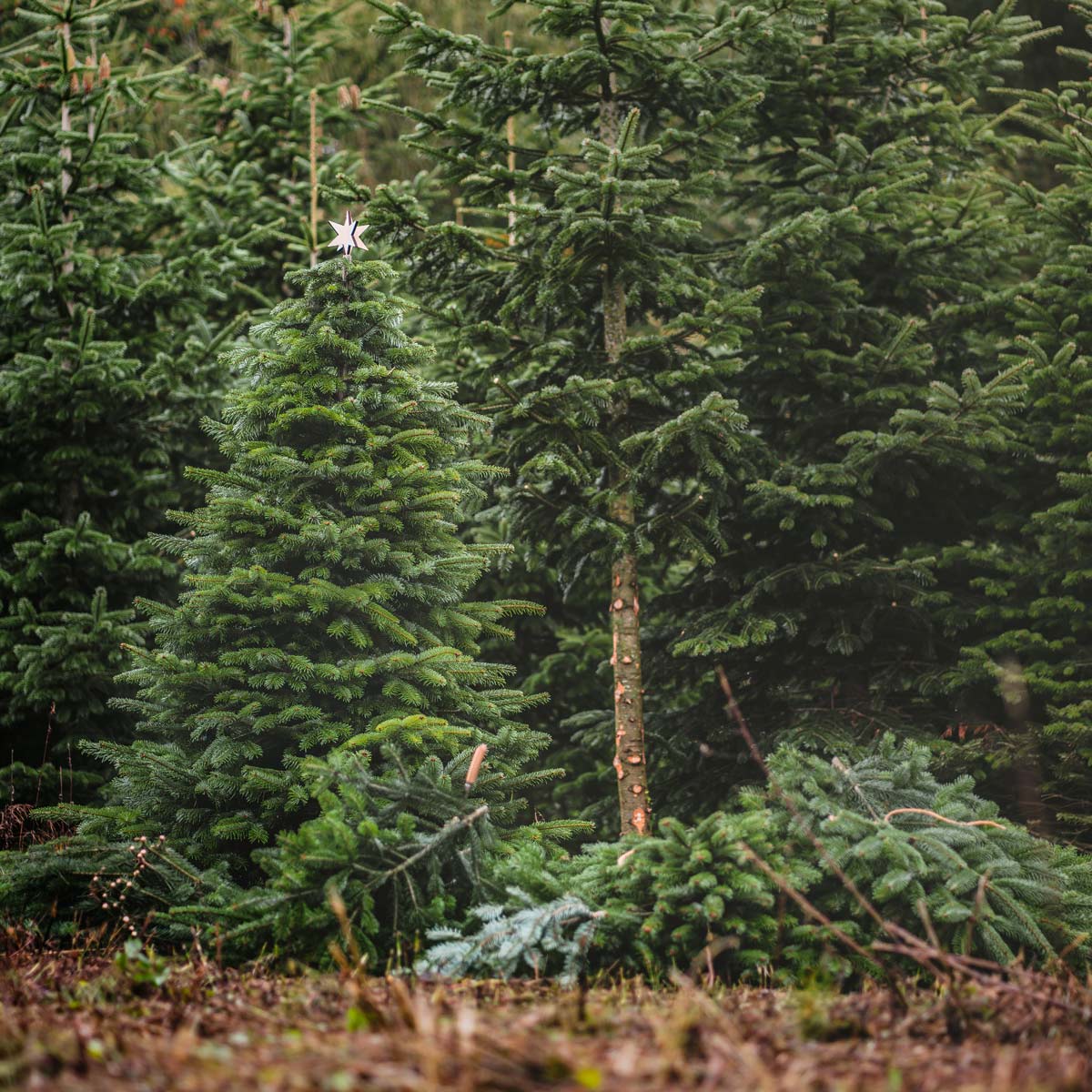It is well known among Christmas tree fans that not all conifers are equally suitable as Christmas trees. Red spruce trees, for example, start needling on the very first day in the living room, and black pines are so resinous that presents placed under them remain stuck there until at least New Year. (However, red spruce and black pine also have special advantages). But which type of Christmas tree is best – and what should you look out for when choosing one?
There are no completely “bad trees” – Every tree has its charm
First of all: every conifer that is sold as a Christmas tree in December also “works” as a Christmas tree – whether Nordmann fir, blue spruce, pine or Nobilis fir. Tree species that are completely unsuitable for use as Christmas trees (such as the larch, which loses all its needles in winter) are not sold as Christmas trees at all. Nevertheless, there are stars and extras among the potential Christmas trees: some Christmas tree species combine a wealth of qualities that make a good Christmas tree, while others have only one good quality (and require a corresponding willingness to compromise).

Common Christmas tree varieties
Nordmann fir – expensive, but good
The Nordmann fir is by far the most popular type of Christmas tree in Germany – three quarters of all tree buyers (75%) regularly opt for a Nordmann fir (source: statista.de). Although it is not a cheap pleasure to have a Nordmann fir as a Christmas tree in your home, the rather high price is justified: It takes almost 15 years for a Nordmann fir to reach “man height”. Then it presents itself with deep green soft needles and sturdy branches that can carry a lot of ornaments. Felled Nordmann firs have an extremely long shelf life.
Nordmann fir – expensive, but blue spruce – fragrant and “prickly”
With a share of around 15 percent, the blue spruce is the second most popular of all Christmas tree varieties. Its needles have a picturesque bluish sheen (hence the name) and a strong scent, but the needles are also hard and pointed. Decorating a blue spruce is therefore no fun. The price of blue spruce is lower than that of Nordmann fir, and it does not keep for quite as long.
Nobilistanne – longest shelf life
The Nobilis fir, also known as the “noble fir”, is the third most popular tree variety; however, together with the exotics, it only accounts for a share of 10 percent. The reason for this is probably their high price: silver firs are generally even more expensive than Nordmann firs. But they also have a longer shelf life. Silver firs are characterized by the silvery sheen on the underside of their needles and their intense, orange-like scent.
Exotic Christmas tree species
Spruce – inexpensive, but “crispy” after a short time
As already mentioned at the beginning, the spruce (or red spruce) has a very short shelf life as a felled tree – extensive needle loss and a quickly developing brown coloration are part of its Christmas program. In addition, red spruce trees rarely grow straight as a die. On the other hand, the Norway spruce is one of the cheapest Christmas tree species because it grows twice as fast as the Nordmann fir.
Pine – visually very striking
The pine is the exotic among the exotics – it very rarely finds its way into a living room in Germany. This may be due to its very independent, barely pyramidal growth and its firm needles, which are almost 15 cm long. Anyone who chooses a pine tree for their Christmas tree will be able to enjoy it for a long time, as the pine is extremely frugal and long-lasting.
Douglas fir – delicate and flexible
The Douglas fir is a relatively “delicate” tree: it has very flexible branches and thin, soft needles. It cannot cope with heavy wooden decorations; the Douglas fir can only carry light Christmas tree baubles or straw decorations. It is similarly inexpensive to spruce and exudes a pleasant citrus scent.
Black pine – durable and resinous
The black pine, also known as “black pine”, is actually native to southern Europe, but is now also cultivated in German forest areas (mainly on the sandy soils of Brandenburg). The black pine has strong branches and is very durable, but, as mentioned at the beginning, it secretes a lot of resin.

Keinachtsbaum®: even more choice
On the other hand, if you make your own Christmas tree from cut greenery or (even easier) buy a Keinachtsbaum® , which can be restocked with cut greenery again and again, you have an even greater choice of tree varieties. You are then not even limited to the genus Abies (firs) or even to conifers, but can also consider conifers, laurels or box trees, for example. Or how about sprigs of European holly? This evergreen plant species from the holly genus was a popular plant decoration in winter centuries before the Christmas tree was established (see History of the Christmas tree). The holly literally “captivates” with its firm leaves, which have alternating upward and downward sloping spines on both sides. This makes decorating holly boughs a little tiring, but the end result looks great.
Conclusion:
There is actually no one-size-fits-all answer to the question of which of the many types of fir tree is best suited as a Christmas tree. Depending on which criteria the buyer considers particularly important, a fir, a spruce or a pine can be the ideal Christmas tree. If, for example, you are primarily interested in a long shelf life, you are best advised to choose a Nordmann fir or a noble fir. If you enjoy the intense scent of the forest, you might go for a blue spruce, and if you don’t want to spend a lot of money, go for a red spruce or a Douglas fir. If, on the other hand, sustainability and the opportunity for creative development play the most important role (with an excellent price-performance ratio in the long term), there is no way around the Keinachtsbaum® .





